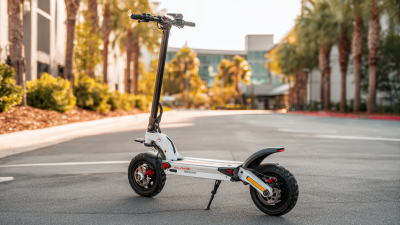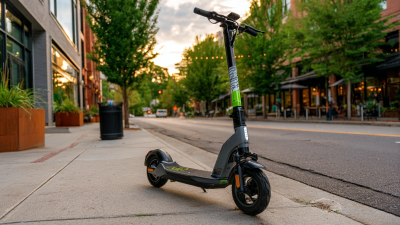As cities around the world strive to become more sustainable and efficient, the adult electric scooter market is poised for remarkable growth, projected to reach $40 billion by 2028. This surge is not only driven by technological advancements but also by a collective shift in urban mobility preferences, as more adults seek convenient, eco-friendly transportation alternatives. According to Dr. Emily Tran, a leading expert in urban transportation solutions, "Adult electric scooters represent a transformational shift in how we navigate our cities—offering quick, efficient, and sustainable travel options for the modern commuter."

As urban congestion becomes increasingly problematic, the adult electric scooter shows promise in alleviating these concerns while integrating seamlessly into existing transit systems. With cities investing in infrastructure that supports micro-mobility options, more individuals are likely to embrace this alternative, making it a focal point in the evolution of urban transport. Furthermore, as safety technology and battery performance continue to improve, the appeal of the adult electric scooter only increases.
The future of urban mobility is indeed bright, with the adult electric scooter leading the charge. As these vehicles become a common sight on city streets, we can expect not just a change in how we travel, but a complete rethinking of urban design and transport policies aimed at future sustainability.
The rise of electric scooters in urban areas represents a significant shift in how cities approach mobility. As urbanization accelerates, cities face increasing congestion and environmental challenges. Electric scooters offer a convenient, eco-friendly solution that allows individuals to navigate urban landscapes with ease. Their compact size and agility enable riders to bypass traffic, access public transit more efficiently, and contribute to reduced carbon emissions.
Moreover, the adoption of electric scooters is not solely driven by practicality; it also aligns with a growing cultural trend favoring sustainability and technology. Many urban dwellers, particularly younger generations, are increasingly looking for alternative modes of transport that reflect their values—namely, convenience, affordability, and environmental consciousness. As electric scooters become more integrated into urban infrastructure, supported by dedicated lanes and charging stations, their popularity is expected to soar, contributing to the projected market growth to $40 billion by 2028. This movement signals a transformative period for urban mobility, promising to reshape how we commute and interact with our cities.
The adult electric scooter market is projected to reach an impressive $40 billion by 2028, driven by several key factors. A notable segment of this market is the global electric scooter sales, which are expected to grow significantly. Reports estimate the global electric scooter market size will expand from $372.32 million in 2024 to $561.2 million by 2032, reflecting a compound annual growth rate (CAGR) of 5.26% during the forecast period. This growth trajectory indicates a rising consumer inclination towards eco-friendly urban transportation solutions.
One of the notable trends in this sector is the evolution of shared mobility models. Unlike traditional bike-sharing or electric vehicle-sharing platforms, electric scooter sharing is emerging as a distinct and appealing option for urban commuting. The increasing urban population, coupled with the rising concerns around pollution and traffic congestion, propels the demand for efficient and convenient mobility solutions. As cities embrace micro-mobility, the adult electric scooter market is set to flourish, showcasing its potential as a sustainable alternative for short-distance travel in urban environments.
As urban areas continue to grapple with congestion and environmental concerns, electric scooters have emerged as a promising solution for short-distance travel. However, the rapid rise of the adult electric scooter market, projected to reach $40 billion by 2028, has not been without its hurdles. Cities face significant regulatory challenges in integrating these scooters into existing transportation networks. The balance between promoting innovative mobility options and ensuring public safety, as well as minimizing disruptions in urban landscapes, is crucial.
Navigating these regulatory challenges involves collaboration between city planners, manufacturers, and the community. Effective policies must address issues such as the safe operation of scooters, designated riding and parking zones, and measures to curb reckless usage. Cities that successfully implement comprehensive regulations can enhance the user experience while maintaining order and safety. As e-scooters become a more integral part of urban mobility, the need for adaptive regulatory frameworks will be essential for fostering a sustainable and efficient transport ecosystem.
Electric scooters are rapidly emerging as a vital component of urban mobility, particularly enhancing last-mile connectivity in densely populated areas. According to a report from Research and Markets, the adult electric scooter market is projected to reach $40 billion by 2028, fueled by increased demand for efficient and sustainable transport solutions. This trend reflects a growing recognition of electric scooters as an excellent means to bridge the distance between public transit hubs and final destinations, reducing reliance on cars and alleviating urban congestion.
The integration of electric scooters into existing transportation networks complements public transit systems by offering users a convenient option to complete their journeys. Studies indicate that nearly 60% of underused public transportation trips could be enhanced by electric scooters, as they provide a flexible and affordable method for navigating the final leg of a commute. By providing easy access to scooters, cities can improve overall mobility, encourage environmentally friendly travel habits, and reduce carbon emissions, making urban spaces more livable and sustainable for future generations.
With the rise of urban mobility innovations, choosing the right
electric scooter becomes crucial for city dwellers.
Factors such as range, weight, and portability should be prioritized to ensure a smooth commuting experience.
It's important to assess your daily travel distance; select a scooter with a range that comfortably exceeds your needs
to avoid the frustration of running out of battery mid-journey.
Tips: When shopping for an electric scooter, consider its weight capacity and design.
If you plan to carry it on public transport or store it in tight spaces, a lightweight and foldable model is ideal.
Additionally, look for features like adjustable handlebars and a comfortable deck to enhance your riding experience.
Safety is another critical element to keep in mind.
Check for scooters that come with reliable lighting and braking systems, as these are essential for navigating busy streets.
Understanding local regulations can also help you make a more informed decision,
ensuring your chosen scooter is suitable for your city’s specific requirements.






